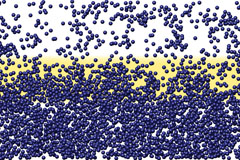Advanced simulations shed light on fluid interfaces (Vol. 46 No. 3)

Any piece of liquid matter requires confinement by solid or fluid boundaries. The simplest case is the interface between liquid and its corresponding vapour. This is subject of ongoing research, pioneered by the Dutch physicist van der Waals 120 years ago. One long-standing problem is about the surface tension at the nanometre scale, for which theory and experiments suggest a high length-scale sensitivity. However, various previous computer simulations found little evidence for this and reached contradictory conclusions.
In this work the authors re-open the case and present a fresh view on fluid interfaces by combining high-performance simulations with proposing a new way of analysing X-ray scattering (GISAXS) experiments. They discover an unexpected dependence of the surface tension on temperature and wavelength, with possibly far-reaching implications for nanoparticle probes, wetting films, and droplet nucleation. The new insight was achieved by utilising novel accelerator hardware, which provides an energy-efficient platform for massively parallel computing and boosts the new supercomputer “Hydra” of the Max Planck Society.
F. Höfling and S. Dietrich, Enhanced wavelength-dependent surface tension of liquid-vapour interfaces, EPL, 109, 46002 (2015)
[Abstract]






